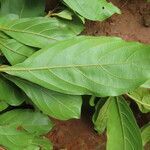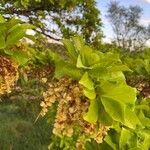Deciduous tree (4-)10-60(-70) m, with plank buttresses, sometimes branching, up to 3 m high and up to 2 m from trunk. Leaves chartaceous to subcoriaceous, usually obovate, less often obovate-oblong or-elliptic or narrowly so, (2-)4-10(-15) x 2-5(-6.5) cm, apex rounded to acute or gradually or abruptly acuminate, base cuneate to attenuate-cuneate, glabrous to sparsely pubescent above, subglabrous to pubescent except usually pubescent on main veins below; domatia pocket-shaped or bowl-shaped; venation eucamptodromous or eucamptodromous-brochidodromous, midvein moderate, prominent, secondary veins 3-5 pairs, distant, originating at moderately or sometimes widely acute angles, curved, prominent, intersecondary veins usually absent, tertiary veins closely and very regularly and conspicuously percurrent; higher order veins occasionally distinct; areolation imperfect or incomplete, slightly prominent petiole 0.2-1.5 cm long, eglandular or biglandular (sometimes more). Inflorescence 5-24 cm long, simple, all flowers bisexual or some to many with reduced female parts; peduncle 1-3 cm long, appressed-pubescent; rhachis 4-21 cm long, appressed-pubescent. Flowers 5-merous, 2.5-4 x 2.5-3.5 mm; lower hypanthium 1.5-2 mm long, densely appressed-or sometimes patent-pubescent, upper hypanthium shallowly campanulate to shallowly infundibuliform, 0.5-1 mm long, appressed-pubescent or sparsely so; calyx lobes suberect to patent, 0.3-0.8 mm long, appressed-pubescent or sparsely so; stamens 2-4 mm long; disk subglabrous to pilose; style 2.5-3.5 mm long, glabrous. Infructescence with numerous fruits disposed along whole length of rhachis; fruit usually straw-coloured, pubescent to sparsely pubescent, 0.5-0.7(-1) x 0.8-1.8(-2.2) cm, variously flattened, transverselyoblong in side view, apex truncate but shortly beaked, base truncate or slightly retuse but sometimes very shortly pseudostipitate, wings 2-5, flexible, unequal, 2 lateral ones 0.3-1 cm wide, rounded or narrowly rounded laterally, the other 3 varying from strong ridges to wings up to 2 mm wide, body 0.15-0.35 cm wide, bulging and keeled to winged on both faces.
More
Large tree up to 30 m. high with buttresses and sympodial branching. Branch-lets rufous-pilose or rufous-sericeous, soon glabrescent. Leaves chartaceous to subcoriaceous, spirally arranged in pseudo-verticels at the ends of the branchlets, petiolate, petiole 1-10 mm. long, rufous-pubescent, lamina obovate or cuneate, abruptly acuminate at the apex, cuneate at the base usually with two glands, 5-10 X 3.5 cm., usually rather sparsely appressed-pubescent or appressed-pilose with hairy domatia in the axils of the principal veins beneath. Flowers white, cream or yellowish-green, apparently all perfect, 5-merous, sessile, in axillary spikes 6-7 cm. long, rhachis tomentellous. Lower receptacle 2-2.5 mm. long, sericeous; upper receptacle shallow-cupuliform, 0.8 X 2 mm., appressed-pubescent. Calyx-lobes deltoid, 0.8 mm. long, usually not reflexed. Stamens 10, filaments 1.8-2 mm. long, anthers subglobose, 0.4 mm. in diam. Disk densely pilose. Style 2 mm. long, glabrous. Fruit about 5 X 10 mm., sparsely pubescent, 5-winged, two wings transversely elongated to about 5 mm., the other three usually rudimentary (or vestigial) not more than 1 mm. in width.




